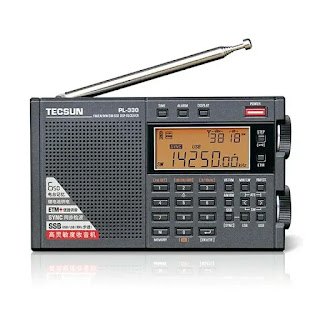How to make a simple DX antenna for your Chinese portable radio with a telescopic small antenna ?
授人以魚,不如授人以漁。
Homemade Simple Sleeve Antenna
To listen to the short wave It can be used both indoors and outdoors.

- Thicker milk tea straw
(Pen holder or paper holder is also acceptable)
- Insulation Tape
- 1.5 square copper core wire
(8-10 meters recommended).

*Wrap one end of the wire
on the straw.
*The wire is directly wrapped around the straw
On, "don't" use peeling
exposed copper core

*Fix with insulating tape
Lower the end of the thread and continue to wind
electric wire……
*The wires stick to each other when winding
close, leave no gaps

*Wrapping length to super
radio whip antenna
The height is appropriate.

*Wrapped and insulated
Tape in place.
*Then connect the ends of the straw more
cut out part
*Sleeve and sleeve to be completed
into the radio's built-in pull
on the rod antenna, see if it is
Can it be fully inserted and
Take it down.
*Finally use insulating tape to adjust
The body fixes the wire so that the
The thread will not fall off or slip
move.

*Connect the other end of the wire to
Connect a clip, use glue
The belt is fixed tightly and conveniently
Fix the antenna on any
place

*The two ends of the antenna are finished,
The sleeve antenna is done!

*One end of the antenna is set on the receiver
on the pole antenna.
*Put one end out of the window (clamp
Metal is preferred), outdoors
Just clamped on the branch.
Using shortwave radio + simple sleeve antenna
*Take the radio and antenna outdoors to an open place.
*It is best to pull the antenna out of the window for indoor listening.
*The end of the antenna has a sleeve, which is set on the pull rod of the radio
On the antenna, the other end of the antenna with the clip extends out.
*It is better to let the antenna have both horizontal receiving surface and vertical receiving surface
receiving side. Vertically facing up or sagging 1-2 meters, the rest
Most of the antenna is stretched out horizontally.
*Antennas don’t need to be pulled straight, but don’t pile them up.
*Hang the antenna above the ground for audition, or listen naturally on the ground
Stretch out and place, change and try to see how it works.
*Walk around and change direction to see if the signal has strengthened
or get better. Different radios and different locations will exist
Different reception experience.

Note 1: [1.5 square copper core wire, length 8-10 meters] is used as a sleeve
Recommended material for tube antennas, try other wires or lengths.
Note 2: Household appliances and walls in the room will shield interference signals, it is best
Go to open places outdoors and avoid: tall buildings, roads, vehicles, electric
Man-made facilities that interfere with electromagnetic radiation, such as utility poles and high-voltage lines.
When there is a metal window frame: the other end of the wire is stripped to expose the copper wire,
Connect the wire copper wire to the metal window frame body.
Example: Find exposed metal contact points on metal window frames, or use
Drill holes and add screws, and alligator clips can be added to connect and fix.
*
When there is a large glass window: the other end of the wire can be directly attached to the window
on the glass. Connect with one or several wires, in the window
A large wire frame attached to the glass, as large as possible
For some, there is no requirement for length or size, and the head and tail should not be airtight.
‧The specific layout depends on the windows and listening conditions
‧The wires should run on the glass to communicate with external signals
‧Do not run wires on the metal window frame, the signal is easily blocked
‧The wires are attached to the glass with a small amount of tape
(Use medical alcohol or glue remover to wipe off the glue)
Indoor window antenna

A crocodile clip or alligator clip[1] is a plier-like spring-tensioned metal clip with elongated, serrated jaws that is used for creating a temporary electrical connection. This simple mechanical device gets its name from the resemblance of its serrated jaws to the toothed jaws of a crocodile or alligator. It is used to clamp and grab onto a bare electrical cable to an lead on a battery or some other electrical component. Functioning much like a spring-loaded clothespin, the clip's tapered, serrated jaws are forced together by a spring to grip an object. When manufactured for electronics testing and evaluation, one jaw of the clip is typically permanently crimped or soldered to a wire, or is bent to form the inner tubular contact of a ~4 mm (0.16 in) female banana jack, enabling quick non-permanent connection between a circuit under test and laboratory equipment or to another electrical circuit. The clip is typically covered by a plastic shroud or "boot" to prevent accidental short-circuits.
Small versions, ranging in size from 15–40 mm (0.59–1.57 in) in length, are used in electrical laboratory work.
You can find a lot of links for portable radios made in PRC
You can also look this antenna homemad for portable radio click on this link
LOOK HERE FOR SWL LOOP ANTENNAS
Look also this free book in PDF
Chapter 13 Page 284



















Aucun commentaire:
Enregistrer un commentaire
Save a comment
Please indicate in your comment your amateur radio callsign, swl, or your email